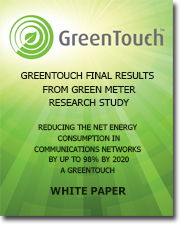GreenTouch Green Meter Research Study
|
GreenTouch has demonstrated that the net energy consumption in an end-to-end network can be reduced by 98% compared to 2010 while supporting a dramatic traffic increase from 2010 to 2020. This net energy reduction, despite the traffic growth, is accomplished due to significant improvements in network energy efficiency: by a factor of 10,000x in mobile networks, by a factor of 254x in fixed access networks and by a factor of 316x in core networks with respect to a 2010 reference scenario defined by GreenTouch. From the initial vision and a preliminary set of ideas, GreenTouch has now proposed an entire portfolio of architectures, technologies, components and algorithms. We have developed comprehensive methodologies to understand and evaluate the energy performance of all these technologies. GreenTouch is proud to share its specific results and set of technologies, protocols and architectures for the mobile access, fixed access and core networks. We invite all industry stakeholders and interested parties to review the findings from the consortium and to continue to build on these results. |
Mobile Access Networks
Green Meter Assessment for Mobile Access Networks- A methodology was developed to evaluate the energy efficiency of large-scale wireless networks and used to benchmark all proposed architectures and technologies that enable the radio access network to provide full coverage and the capacity and performance required in 2020. The final mobile architecture is created by selecting the most energy-efficient technologies for each deployment area, such as city centers or rural areas. Read More
- White paper for mobile access networks Read More
- An advanced power model and online tool was developed that provides a fundamental understanding and a realistic evolution of the power consumption and hardware capabilities for a diversity of wireless base station types and operating conditions. Read More
- Use the Power Model Software Tool
- The BCG2 project goes beyond the traditional network architecture by using small cells, and by completely separating the signaling and data functions at the wireless interface allowing for intelligent on-off management of the small cells. Read More
- The LSAS approach utilizes a large number of physically small, low-power, individually controlled antennas to create a multiplicity of user-selective beams of data. The data-bearing power is only directed where it is needed and avoids unnecessary interference. Read More
- A combination of physical and medium access control technologies that allocate the wireless air interface resources in the optimal tradeoff between energy efficiency and spectral efficiency. Read More
- A new redesigned receiver structure that operates better with lower signal quality and is able to mitigate poor channel quality and interference through an improved synchronization and iterative channel estimation / equalization approach. Read More
- A new interference alignment methodology that reduces the inter-cell interference through new precoding and scheduling algorithms to ensure that cell-edge users perceive an almost interference-free signal, thereby leading to greater spectral efficiency and reduced base station transmit power. Read More
Fixed Access Networks
Green Meter Assessment for Fixed Access Networks- A new network architecture integrating key technologies is defined to improve the energy efficiency of residential and enterprise fixed access and metro aggregation networks. The performance of this architecture is evaluated through a mathematical model that captures the energy savings at the component level and has the ability to compute the overall system-level energy savings. Read More
- White paper for fixed access networks Read More
- The Bit-Interleaving Passive Optical Network protocol introduces the concept of “power follows user traffic load” by taking advantage of the fact that the user traffic is only a fraction of the aggregate downstream traffic. The cascaded bit-interleaving extends the basic concept to the access and metro network for efficient data processing at any network node.
Read More
- The virtual home gateway approach replaces in-home and energy-consuming residential gateways with smaller interface equipment and virtualizes the corresponding service functionalities on generic shared servers located in the cloud network. Read More
- A new energy optimized optical transceiver was designed for point-to-point links with a data rate up to 1 Gbps using an innovative hardware design and an intelligent adaptive power control mechanism. Read More
Core Network
Green Meter Assessment for Core Networks- An energy-optimized core network architecture integrating key technologies, hardware optimizations and intelligent control algorithms is investigated. A multi-layer network optimization framework was used to assess the relative and cumulative impact on network energy efficiency of the respective technologies. Read More
- White paper for core networks [to be added later]
- A new analytic optimization framework to minimize the power consumption of content distribution networks was introduced leading to more distributed clouds and data centers located closers to the end users. Algorithms are developed for the number and placement of the clouds and the distribution of the content objects. Read More
Services, Policies and Standards Activities
- An overview of the main responsibilities of the working group is provided, including the development of the traffic volume and growth projections, standards contributions and engagements with policy and other organizations in the ecosystem. Read More


